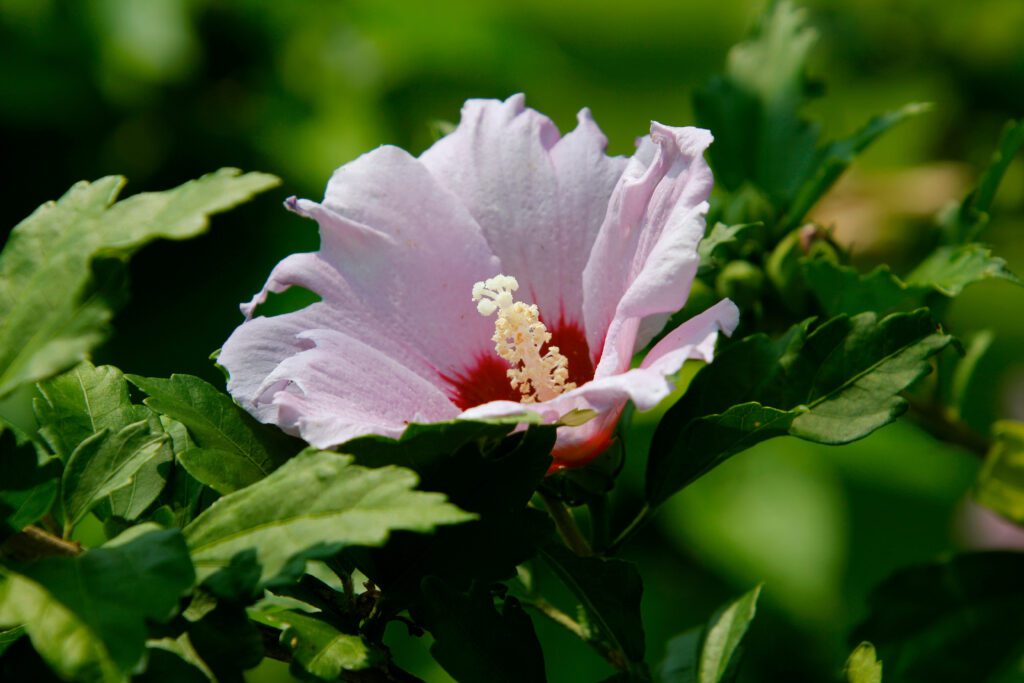July 28, 2025
Rose of Sharon: A Summer Showstopper for New England Gardens
If you’re looking to add a bold splash of color to your garden during the dog days of summer, Rose of Sharon (Hibiscus syriacus) might be just the shrub you’re looking for. With large, tropical-looking blooms that last from midsummer well into fall, this hardy hibiscus is a favorite for gardeners who want long-lasting color with minimal fuss.
What Is Rose of Sharon?
Rose of Sharon is a deciduous shrub that’s part of the hibiscus family—yes, the same family as those showy tropical hibiscus you see in warmer climates. But unlike its tropical cousins, Hibiscus syriacus is winter-hardy in New England (Zones 5–9), making it a reliable bloomer even after the toughest winters.
The blooms come in a range of colors including lavender, white, pink, blue, and bicolor options, with many varieties featuring prominent contrasting centers or frilly double petals. Hummingbirds, butterflies, and bees love them, while deer and rabbits typically steer clear—making them a great addition to pollinator gardens in suburban and rural areas alike.

Hibiscus syriacus ‘Aphrodite’
Why Gardeners Love It
- Blooms When Others Don’t: Most shrubs finish their floral display by early summer, but Rose of Sharon begins its show in July and keeps going through September.
- Low Maintenance: Once established, it’s drought tolerant, cold hardy, and needs minimal pruning.
- Versatile: Works well as a hedge, specimen plant, or even in a large container.
- Pollinator-Friendly: Great for supporting hummingbirds, bees, and butterflies in the late season.
Top Tips for Growing Rose of Sharon
1. Pick the Right Spot:
Rose of Sharon loves full sun (at least 6 hours a day), but it will tolerate light afternoon shade. Make sure your spot has well-drained soil, and avoid overly wet areas.
2. Give It Space:
Depending on the variety, these shrubs can reach 6–12 feet tall and 4–6 feet wide. If you’re planting more than one, space them at least 5–6 feet apart for good airflow and shape.
3. Water to Establish:
In its first year, make sure to water deeply and regularly. Once established, it becomes relatively drought tolerant.
4. Prune in Early Spring:
Rose of Sharon blooms on new wood, so pruning in early spring before new growth emerges is ideal. You can shape it or cut it back hard to encourage bushier growth and more blooms.
5. Watch for Seed Pods:
Some older varieties can be prolific self-seeders. Deadheading (removing spent flowers) can help control unwanted seedlings. Many newer cultivars are sterile and don’t produce seed.

Hibiscus syriacus ‘Blue Chiffon’
Favorite Varieties to Try
- ‘Blue Chiffon’ – Soft lavender-blue flowers with a lacy double center. Elegant and refined.
- The ‘Satin’ Series – This popular seedless series includes stunning single-flower varieties like Blue Satin, Orchid Satin, Rose Satin, Violet Satin, Purple Satin, and Ruffle Satin. Each offers bold color and a refined, upright habit that works beautifully in borders or as stand-alone accents.
- ‘Lil’ Kim’ Series – A dwarf selection (3–4’ tall) with rich blooms and a deep burgundy center. Great for smaller gardens.
- ‘White Pillar,’ ‘Red Pillar,’ and ‘Purple Pillar’ – Upright, columnar habits make these ideal for tight spaces or vertical accents.
- ‘Diana’ – Pure white, large blooms with no red center. A classic beauty that glows at dusk.
Whether you’re building a late-season border, creating a pollinator paradise, or just want a worry-free pop of color, Rose of Sharon delivers. Stop by your local Mahoney’s to explore our selection of varieties and find the perfect fit for your garden.
